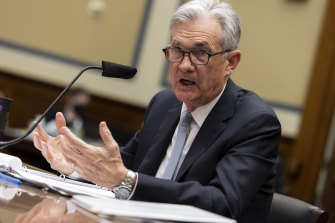‘Worse than Lehman’: Wall Street’s rout triggers some GFC memories
By Ye Xie, Isabelle Lee, Amelia Pollard and Peyton Forte
Quincy Krosby couldn’t wait for Monday’s Wall Street trading session to be over.
“I was glued to the screen,” LPL Financial’s chief equity strategist said in an interview.
It was just one of those days with losses so gigantic that solely looking at stocks wasn’t enough. Her eyes strayed to bonds, to credit default swaps and elsewhere as she tried to figure out how bad things were and might get.

Wall Street’s benchmark is now in a bear market.Credit:AP
What she saw was ugly. Even by the standards of this volatile year, Monday’s wild ride throughout financial markets stands out. Two-year US Treasury yields surged 29 basis points as bond prices tanked. The yield jumped 54 basis points since Thursday night, the biggest two-day increase since 2008, a sign of just how rapidly traders are adjusting where they think the Federal Reserve will take interest rates.
All but five stocks in the S&P 500 tumbled, and the benchmark posted a more than 20 per cent loss since its January peak, thus crossing into a bear market.
Cryptocurrencies plummeted so violently that a popular lending platform froze withdrawals to prevent a very modern kind of bank run. Over in old-school currencies, the US Dollar Index roared to the highest level in almost two decades as investors sought safety.
It was enough, for some, to resurface scary memories of the global financial crisis more than a decade ago. Christian Hoffman, a portfolio manager for Thornburg Investment Management, said market liquidity has deteriorated so much that he’s thinking about the dark days of 2008.
“Liquidity in the market is worse than it was leading up to Lehman,” said Hoffman, who worked at the firm that imploded back then, triggering the worst financial crisis since the Great Depression. It’s the kind of problem that can exacerbate losses in a big way. “That creates even more risk, because if the market doesn’t have liquidity, it can gap down very quickly.”
Since a surprisingly hot inflation report on Friday, investors have become increasingly worried that the Fed will have to tighten monetary policy so aggressively that it tips the economy into a recession. Economists at JPMorgan Chase & Co, Goldman Sachs and Nomura Holdings Monday joined their peers at Barclays and Jefferies to call for the central bank to announce a 75-basis-point hike on Wednesday, which would be the biggest increase since 1994.

There are calls for Jerome Powell’s Fed to lift rates by 75 points this week. Credit:AP
Instead of serving as a haven in times like this, the Treasury market and its huge spike in yields has become a catalyst for the market-wide plunge. It reminded Priya Misra of former President Bill Clinton’s political adviser, James Carville, who famously observed that he’d like to be reincarnated as the bond market given how intimidating it is.
“It was quite the day. Like a freight train approaching and you can’t turn anywhere for help,” said Misra, global head of rates strategy at TD Securities. “Today the bond market was present in all ferociousness!”
Subadra Rajappa, head of US rates strategy at Societe Generale, said poor liquidity, some “panic selling” and margin calls contributed to Monday’s rout. But even that couldn’t fully explain the market moves, she said.
Rajappa spent all day fielding calls from clients and scuttled between internal virtual meetings while working from home in Manhattan. A few clients were scratching their heads trying to figure out why the markets have sold off so much.
“People are trying to process what’s behind these large moves,” said Rajappa. “We don’t know for sure.”
Bloomberg
The Business Briefing newsletter delivers major stories, exclusive coverage and expert opinion. Sign up to get it every weekday morning.